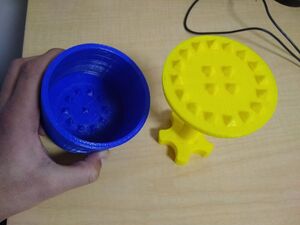Powder maker - Chilies and herbs
Appearance

Herbs, spices and chillies are produced in India and Brazil extensively. But lack of simple and cost-effective technology is a big issue in rural regions of such developing countries. Usually, herbs and dried chillies are made into a powdered form using heavy stones for crushing purpose. Thus considering the amount of input work and its output, I have designed a simple but robust grinder which is very cost effective and can be used by anyone for the same purpose.
Bill of Materials[edit | edit source]
PLA filament- $1
Tools needed[edit | edit source]
- MOST Delta RepRap or similar RepRap 3-D printer
- PLA Filament
Skills and knowledge needed[edit | edit source]
- 3D Modelling Software
- Matter control software
Technical Specifications and Assembly Instructions[edit | edit source]
- Download the .stl files from YouMagine website.
- Use at least 20% infill in CURA or any other matter control software to ensure the robustness needed for this device to work.
- The setting parameters for outer layer thickness and print quality should be really accurate in order to print the teeth on both parts really sharp.
- The print time required for both the parts to print is around 5 hours due to the fine printing.
- The cost associated with this product is really less as it uses both 3D printed parts.
Common Problems and Solutions[edit | edit source]
- The teeth might break due to excessive force on the product to grind. This problem can be easily solved by increasing the height of the teeth.
- To increase the efficiency of this device, one can also increase the number of teeth on both the parts.
- The teeth orientation can be altered if different types of objects are to be grounded.
Cost savings[edit | edit source]
- The estimated cost of this device is around $1.50 and can be further reduced if the part is mass produced using less expensive material.
- commercial model [1]
- $10-$15 can be saved by printing each of this device.